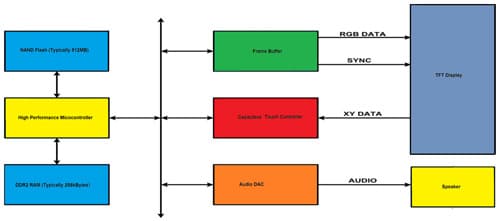Market analysis company IDTechEx pointed out that more than half of the current global touch screen market uses capacitive touch (using surface capacitance or projected capacitive sensing mechanisms) and is widely used in many mobile consumer products such as smartphones and tablets ; In addition, capacitive touch has also been used in other fields, including household appliances, industrial control equipment and smart homes. Although the low-cost resistive touch screen is also suitable for many products, the human-machine interface (HMI) based on the capacitive touch screen can simultaneously increase the display brightness and response time, which has led to more and more projects. People are rushing, and multi-touch functions based on capacitive touch sensing technology are expected to become the mainstream of HMI in the next few years.
Multi-touch operation can detect many complex actions and provide users with a more intuitive and simple operation method. In addition, multi-touch allows multiple people to use the same human-machine interface at the same time, creating a user experience shared by multiple people. If capacitive touch can achieve the above-mentioned functions, it is obvious that the engineering team will generally use the traditional human-machine interface design architecture to ensure that they can implement this technology in the most effective way.
Object-oriented simplified multi-touch circuit
In general, the basic architecture of a multi-touch circuit requires many chips, including a high-performance microprocessor (usually requiring 32 bits) and a fairly large flash memory to store image data. There is also a large-capacity frame buffer (Frame Buffer) used to map data to the display screen (Figure 1); many parallel interfaces are responsible for the communication between the various integrated circuits (IC) in the circuit, which is It is an application with high space requirements, which will be greatly restricted.

Figure 1: Block diagram of a common multi-touch HMI system
Conversely, a simpler and more streamlined multi-touch human-machine interface eucalyptus can easily adjust the size of the picture by controlling the expansion / contraction of the user's two fingers, or you can use your finger to flip Change the direction of the image; there are other finger operation functions, such as clicking, page turning, scrapbooking, sliding left and right, and two-finger long press.
The uniqueness of this system is based on the object-oriented design. Objects can be pictures, text, gadgets and overlapping effects, as well as specific sounds such as beeps, chirps, etc .; the image content can not be pixelated as traditional Units are drawn line by line (at 1/16 pixel resolution).
This new object-oriented approach (from an advanced graphics controller IC) eliminates the need for Frame Buffer or large memory resources to store image content, and allows the use of low-level, inexpensive 8-bit or 16-bit microprocessors, Therefore, the number of components of the system can be significantly reduced, and the space occupied by the circuit board is relatively small, which not only shortens the development time, but also greatly reduces the workload of research and development. The microprocessor in this example was developed using the low-cost ATMEG 328P and its tools in the free ArduinoPro development kit.
The graphic control component of this system adopts the FT801 series of FTDI embedded graphics engine (EVE) components, through I2C interface and the built-in FT801 touch protocol, connected with a standard capacitive touch controller device to achieve . This device can determine the position of more than five contact points at the same time, even the most complex finger sensory activities can be detected; the built-in function can also reflect up to 255 touches according to the touch state Control object label notification.
This product can support WQVGA and QVGA format display (resolution up to 512 × 512 pixels), as well as 18-bit red, green and blue (RGB) display and 2-bit color technology. This small package, highly integrated embedded graphics engine component, operating voltage is 3.3 volts (V); built-in embedded read-only memory (ROM) has a variety of different objects, including various sounds and fonts, for Engineers engaged in the creation of HMI provide sufficient design flexibility to create different differentiated products; internal Alpha blending and anti-aliasing technology greatly improve the image display effect; in addition to the touch controller interface, the highly integrated embedded drawing engine also includes a Audio output, can be connected to external speakers.
Capacitive touch HMI is promising
The capacitive touch panel has many operational advantages, so this technology will grow highly in the next few years; as long as you understand the design method clearly and find advanced chip solutions, the capacitive touch HMI will have better performance. .
The above circuit example proves that using an innovative method to process images and sounds in an object way instead of the traditional heavy data way can realize a kind of man-machine shorthand.
The system using a new generation of graphics display controller chips only needs to use fewer components and a low-frequency wide interface to complete a complex HMI system with a voice interface, while also greatly reducing costs and production complexity.
EMI Suppression,EMI Suppression Components,Emi Suppression Bead,EMI Suppression Components Ferrite Core
Jinan Filtemc Electronic Equipment Co., Ltd. , https://www.chinaemifilter.com